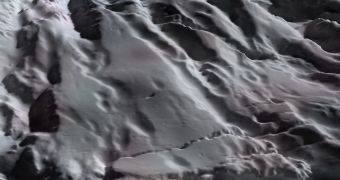According to the conclusions of a new scientific study, it would appear that the Saturnine moon Enceladus experiences constant snow fall. Researchers have determined that large amounts of frozen precipitations fall to the space object's surface from its wispy-thin atmosphere.
The phenomenon was discovered through high-resolution maps of Enceladus, which were produced using the NASA Cassini spacecraft. The probe has been orbiting the gas giant, its rings and its moons since July 1, 2004.
Over the past couple of years, scientists have made a number of remarkable discoveries about the Saturnine moon, including the fact that it contributes matter to the gas giant's E Ring and that some of the water it spews out of tiger stripe features at its south pole makes its way in the planet's atmosphere.
The team that conducted the new investigation included expert Paul Schenk, who holds an appointment at the Lunar and Planetary Institute (LPI), in Houston, Texas, Space reports. He explains that Enceladus is in fact covered in superfine ice crystal particles.
Due to the special traits the moon's atmosphere displays, the precipitations fall to the surface at a very slow and steady pace, when compared to blizzards here on Earth. The total yearly snowfall does not exceed a thousandth of a millimeter, experts say.
In order for a layer of snow about 100 meters (320 feet) tall to accumulate, the moon would need several tens of million of years of constant precipitations. Still, the fact remains that Enceladus is one of the few objects in the solar system where such a phenomenon has been discovered.
Most of the snow and ice particles are produced by the moon itself. The object is made up of a miles-thick ice crust surrounding what experts hypothesize to be an ocean of liquid water. The tiger stripe features release some of these vapors through a series of complex physical processes.
Some of the ice particles go to Saturn's atmosphere, others in the gas giant's E Ring, and others still fall to the surface of the moon itself. Researchers determined in the new investigation that the pattern in which these snow flakes fall is predictable.
“The discovery by instruments aboard the Cassini orbiter that there's a currently active plume of icy dust and vapor from Enceladus has revolutionized planetary science,” Schenk says.
“Earlier this year, we published work that showed material from Enceladus's plumes coats the surfaces of Saturn's icy moons. Now we've uncovered two lines of evidence that point to thick deposits of plume material coating the surface of Enceladus itself,” he adds.

 14 DAY TRIAL //
14 DAY TRIAL //